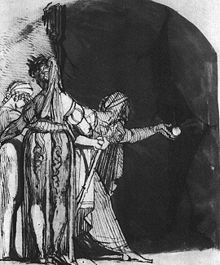

InGreek mythology, the Graeae (Ancient Greek: Γραῖαι; /ˈɡriːiː/; English translation: "old women", alternatively spelled Graiai and Graiae) were three sisters who had gray hair from their birth and shared one eye and one tooth among them.[1] They were also called the Grey Sisters and the Phorcides ("daughters of Phorcys").[2]
Their names were:

The word Graeae is probably derived from the adjective γραῖα graia "old woman", derived from the Proto-Indo-European root *ǵerh₂- *ǵreh2-, "to grow old" via Proto-Greek: *gera-/grau-iu.[3]
The Graeae were daughters of the sea-deities Ceto and Phorcys (from which their name the Phorcydes derived) and sisters to the Gorgons.[4] The Graeae took the form of old, grey-haired women. Their age was so great that a human childhood for them was hardly conceivable. In Theogony, however, Hesiod describes the Graeae as being "fair-cheeked". In Prometheus Bound, the Graeae are described as being swan-shaped ("κυκνόμορφοι").[5]

Hesiod names only two Graeae, the "well-clad" Pemphredo (Πεμφρηδώ "alarm") and the "saffron-robed" Enyo (Ἐνυώ).[6] Pseudo-Apollodorus lists Deino (Δεινώ "dread", the dreadful anticipation of horror) as a third.[7] Calling them "Phorcides", Hyginus, in addition to Pemphredo and Enyo, adds Persis, noting that "for this last others say Dino".[8]
They shared one eye and one tooth, which they took turns using. By stealing their eye while they were passing it among themselves, the hero Perseus forced them to tell the whereabouts of the three objects needed to kill Medusa (in other versions, the whereabouts of Medusa) by ransoming their shared eye for the information.[4]
| Gaia | |||||||||||||||||||||||||||||||||||||||||||||
| Pontus | |||||||||||||||||||||||||||||||||||||||||||||
| Nereus | Thaumas | Phorcys | Ceto | Eurybia | |||||||||||||||||||||||||||||||||||||||||
| Echidna | The Gorgons | The Graeae | Ladon | The Hesperides | Thoosa[9] | ||||||||||||||||||||||||||||||||||||||||
| Stheno | Deino | ||||||||||||||||||||||||||||||||||||||||||||
| Euryale | Enyo | ||||||||||||||||||||||||||||||||||||||||||||
| Medusa[a] | Pemphredo | ||||||||||||||||||||||||||||||||||||||||||||
|
Ancient Greek deities
| |||||||||||||
|---|---|---|---|---|---|---|---|---|---|---|---|---|---|
| Primordial deities |
| ||||||||||||
| Titans |
| ||||||||||||
| Olympian deities |
| ||||||||||||
| Water deities |
| ||||||||||||
| Chthonic deities |
| ||||||||||||
| Personifications |
| ||||||||||||
| Other deities |
| ||||||||||||